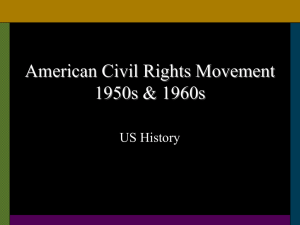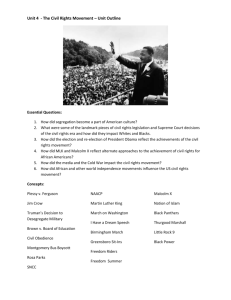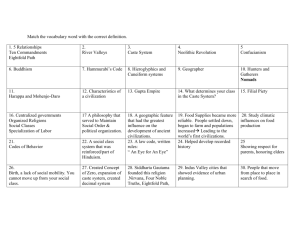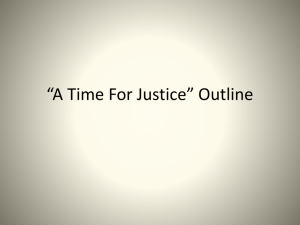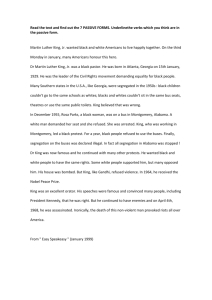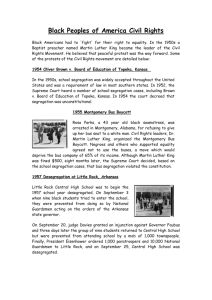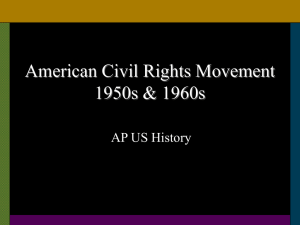APCivilRights
advertisement
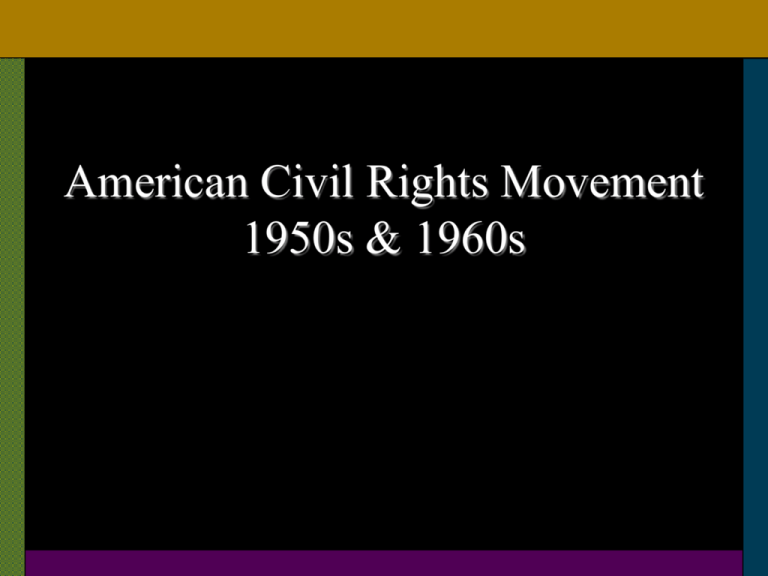
American Civil Rights Movement 1950s & 1960s Historical Background • Slavery – Property vs. Human beings – Slave codes • No education, marriage, separate church, freedom of movement • Post Civil War – 13th, 14th, 15th Amendments – Jim Crow laws – legal separation • Plessy v. Ferguson – Supreme Court upholds separate but equal facilities or services is protected by the Constitution Historical Background • Post Civil War (continued) – Limit voting rights, property rights (Poll tax, literacy test, grandfather clause) – Limit economic opportunity – Maintain status quo through violence (KKK, lynching) or laws • WWI and WWII – Segregated units • Post WWII – President Truman orders U.S. armed forces to be desegregated (1947) Lynching in America Origin of the Civil Rights Movement • World War II • 1. African-Americans left sharecropping jobs for industrial jobs in Northern cities • 2. 700,000 African-Americans served in WW II – “We return from fighting. We return fighting.” • 3. During WWII, AfricanAmericans protested against Jim Crow Laws—were successful Who was Linda Brown? • Brown v. Board of Education (Topeka, Kansas) 1954 – Facts • Linda Brown = 8 year old African American student • Nearest elementary school = 4 blocks from the Brown home (all white) • Linda Brown’s school (all black) = 21 blocks from the Brown home • NAACP sues Bd of Education challenging the separate but equal Origin of the Civil Rights Movement • Thurgood Marshall • Later became the first African-American Supreme Court Justice Brown v. Board of Ed • Supreme Court orders desegregation be implemented with all ‘possible’ speed • “Separate but equal inherently unequal” Important Court Victories • Desegregated interstate buses • Desegregated law schools • Desegregated graduate schools Leaders Of The Civil Rights Movement Jackie Robinson Born in Cairo, Georgia, in 1919. At the University of California in Los Angeles, Robinson starred in football, track, basketball and baseball. In 1944, Robinson played in the Negro leagues on a team called the Kansas City Monarchs. 42 Playing for the Dodgers In 1946 Branch Rickey signed Jackie Robinson. Jackie Robinson, at the age of 27, became the first Black Baseball player in Major League history. Jackie and Civil Rights Jackie Robinson’s Actions affected the world far beyond Major League Baseball. His courage and discipline in standing up against racism were a preview of the actions taken by many members of The Civil Rights Movement. Rosa Parks Rosa Parks was born on February 4, 1913. In the South, Jim Crow laws segregated African American’s and whites in almost every aspect of life. – This included a seating policy on buses. White’s sat in the front, Blacks sat in the back. – Buses also drove White students to school. Black students were forced to walk. Events Leading Up To Rosa’s Protest Parks was an active member of The Civil Rights Movement and joined the Montgomery chapter of NAACP (National Association for the Advancement of Colored People) in 1943. In 1944 Jackie Robinson refused to give up his bus seat in Texas. In 1955, Black Activist in Montgomery were building a case around Claudette Colvin, a 15 year old girl who refused to give up her seat on a bus. She was arrested and forcibly removed from the bus. African Americans made up 75% of the passengers in the Bus system but still had to deal with unfair rules. The Arrest On December 1, 1955 Rosa Parks refused to give up her seat to a White man on a bus. Parks was arrested and charged with the violation of a segregation law in The Montgomery City Code. 50 African American leaders in the community met to discuss what to do about Rosa’s arrest. “People always say that I didn't give up my seat because I was tired, but that isn't true. I was not tired physically, or no more tired than I usually was at the end of a working day. I was not old, although some people have an image of me as being old then. I was forty-two. No, the only tired I was, was tired of giving in.” Rosa Parks Autobiography Montgomery Bus Boycott On December 5, 1955, African Americans in Montgomery began to boycott the busses. 40,000 Black commuters walked to work, some as far as twenty miles. The boycott lasted 382 days. The boycott ended after the Supreme Court ruled the law unconstitutional. Martin Luther King Jr. • In 1953, at the age of 26, King became pastor at the Dexter Avenue Baptist Church in Montgomery Alabama. • His start as a Civil Rights leader came during the Montgomery Bus Boycott. Montgomery, Alabama • Martin Luther King Jr. • Studied tactics of Thoreau, Gandhi, and others • Preached about soul force—non-violent resistance • “We will not hate you, but we cannot . . . obey your unjust laws” Non-Violent Tactics • Boycott • Refusing to buy a good or service • Sit-in • Sitting in segregated areas and refusing to move • March • Marching with a large group to draw attention to a cause King Becomes a National Figure • His start as a Civil Rights leader came during the Montgomery Bus Boycott. • Southern Christian Leadership Conference (SCLC) • Civil Rights group organized by King • Included over 100 African-American ministers Civil Disobedience • In 1957 King helped found the Southern Christian Leadership Conference (SCLC). A group that used the authority and power of Black churches to organize non-violent protest to support the Civil Rights Movement. King believed in the philosophy used by Gandhi in India known as nonviolent civil disobedience. He applied this philosophy to protest organized by the SCLC. The civil disobedience led to media coverage of the daily inequalities suffered by Southern Blacks. The televised violence led to mass public sympathy. The Civil Rights Movement became the most important political topic during the early 60’s. Little Rock, Arkansas—1957 • Nine African-American students were to integrate Central High School • Governor ordered Arkansas National Guard to turn the students away • Federal judge ordered the governor to allow the students entry • Governor refused—African-American students were turned away Little Rock, Arkansas—1957 • Eisenhower responds • Put 1,000 paratroopers in Little Rock • Stationed in the High School—escorted students to class, maintained order The Movement Grows • Student Non-violent Coordinating Committee (SNCC) • Group of AfricanAmerican college students in North Carolina Greensboro, North Carolina • SNCC used sit-ins to protest segregated lunch counters • Media coverage showed racism to the entire country • By 1960, 48 cities had desegregated lunch counters Freedom Riders • Wanted to test enforcement of Supreme Courts decision to desegregate interstate buses. • Blacks and Whites rode through the South Freedom Riders • Peck (a civil rights activist) rode on Bus One. At the Alabama state line, a half dozen white racists got on the bus, carrying chains, brass knuckles, and pistols. They yanked the young AfricanAmerican riders from their seats and shoved them into the aisle. Peck and a 60-year-old white freedom rider tried to intervene. The thugs knocked Peck unconscious and kicked the old man repeatedly in the head until his brain hemorrhaged. Freedom Riders • When Bus One got to Birmingham, Alabama, a mob was waiting at the bus terminal, many holding iron bars and pipes. As they entered the white waiting room, they were dragged into the alley and beaten with the pipes. Peck was again knocked unconscious, this time he needed 53 stitches in his head and face. Freedom Riders • In Anniston, Alabama, 200 whites attacked Bus Two and slashed its tires. Six miles out of town, the bus was crippled. The mob barricaded the door, smashed a window, and tossed a fire bomb into the bus. The freedom riders were barely able to force the door open and escape before the bus exploded. Freedom Riders • Another group of freedom riders rode from Tennessee into Alabama. When they reached Birmingham, the Police Chief had them pulled off the bus, beaten and driven back to Tennessee. The freedom riders returned to Birmingham. When they proceeded to Montgomery, a white mob had formed and no police were present. The freedom riders were again beaten. John F. Kennedy finally sent 400 U. S. Marshals to protect the riders as they continued to Mississippi Ole Miss • James Meredith won a court case that would make him the first African-American student at the University of Mississippi. Ole Miss • Mascot – Rebels • Symbol – Confederate Flag Ole Miss • Federal Marshals escorted Meredith to register • Riots ensued – 2 dead, 200 arrested, 5000 soldiers needed to stop the rioters Birmingham, Alabama – 1963 • • • • Demonstrations to protest segregation King was arrested – released Children’s March- 959 were arrested 2nd Children’s March – police used fire hoses, attack dogs against the marchers • Finally, negative media attention, boycotts, and protests led to desegregation Letter From a Birmingham Jail • King, wrote the letter after being arrested at a peaceful protest in Birmingham, Alabama. The letter was in response to a letter sent to him by eight Alabama Clergymen called, “A Call For Unity.” The men recognized that injustices were occurring in Birmingham but believed that the battles for freedom should be fought in the courtroom in not in the streets. In the letter, “Letter from Birmingham Jail,” King justified civil disobedience by saying that without forceful action, true civil rights would never be achieved. Direct action is justified in the face of unjust laws. Jackson, Mississippi – 1963 • Civil Rights activist Medgar Evers was killed in his driveway • The killer, Byron de la Beckwith was released after two trials (hung jury) Washington, D. C. – 1963 • March organized to persuade Congress to pass Civil Rights Bill • 250,000 met to hear speeches, music • “I Have a Dream” speech – Martin Luther King, Jr. • After Kennedy was shot, Civil Rights Act of 1964 passed I Have A Dream Speech • • • In a powerful speech, Martin Luther King Jr. stated eloquently that he desired a world where Black and Whites could coexist equally. King’s speech was a rhetoric example of the Black Baptist sermon style. The speech used The Bible, The Declaration of Independence, The United States Constitution and The Emancipation Proclamation as sources. I Have A Dream Speech • The powerful words of Martin Luther King Jr. “I have a dream that one day this nation will rise up and live out the true meaning of its creed: - 'We hold these truths to be selfevident, that all men are created equal.’” “I have a dream that one day even the state of Mississippi, a state sweltering with the heat of injustice, sweltering with the heat of oppression, will be transformed into an oasis of freedom and justice.” “I have a dream that my four little children will one day live in a nation where they will not be judged by the color of their skin but by the content of their character.” “Black men and White men, Jews and Gentiles, Protestants and Catholics - will be able to join hands and sing in the words of the old Negro spiritual: "Free at last! Free at last! Thank God Almighty, we are free at last!" Mississippi – 1964 • Freedom Summer – 1000 college students went to Mississippi to register AfricanAmericans voters • Met violent resistance—4 dead many wounded, churches and businesses burned Selma, Alabama – 1965 • Voter registration drive – 2,000 AfricanAmericans arrested, police beatings • Police killed a demonstrator • King announced a protest March from Selma to Montgomery • State police beat marchers, used tear gas • Federal government stepped in protected marchers • 25,000 marchers reached Selma Selma, Alabama – 1965 • Voting Rights Act of 1965 passed— eliminated the literacy test • Allowed federal government to enroll voters who were denied suffrage • Twenty-Fourth Amendment— eliminated the poll tax Watts, 1965 Black Power • Slogan coined by Stokely Carmichael (SNCC) • African-Americans should separate from whites, define their own goals, and lead their own organizations • Signaled a shift away from non-violent resistance Black Power Detroit, 1967 Mexico City, 1968 Tommie Smith and John Carlos Tommie Smith and John Carlos give the Black Power salute at the 1968 Summer Olympics. The two men were suspended by the United States team and banned from Olympic village. The action is considered a milestone of The Civil Rights Movement. Black Panther Party • • • • U.S. African American Militant group. Founded in 1966 in Oakland. Led by Huey P. Newton and Bobby Seale. Believed violent revolution was the only way to receive freedom. • Urged African Americans to arm themselves. The Violent Panthers • • • In the late 60’s party leaders got involved in violent confrontations with the police. Huey Newton was tried in 1967 for killing a police officer. Black Panther activist Bobby Seale, was a member of the Chicago Eight. A group of eight people who disrupted the 1968 Democratic convention. Black Panthers • • • • • Black Power Black Militancy—suggested armed revolt “Power flows out of the barrel of a gun” Communist Got into shootouts with police Black Panthers • Sold copies of Mao Zedong’s Little Red Book to raise money so they could purchase shotguns Black Panthers • Started free daycare and free breakfast program in urban ghettos • Made them popular in Northern cities Black Panthers Black Panthers Black Panthers • J. Edgar Hoover (head of the F. B. I.) declares that the Black Panthers were the "greatest threat to the internal security of the country." Black Panthers • Begin to unravel • Leaders are sent to jail, flee the country, killed by police Malcolm X X Born in Omaha Nebraska, Malcolm Little was the son of a Baptist preacher who urged Blacks to stand up for their rights. X His father was killed by White Supremacist in Michigan, in 1931. X After time, Malcolm moved to Harlem where he became involved in gambling, drug dealing and robbery. X Malcolm was arrested at the age of 20 for armed robbery. In jail he studied the teaching of Elijah Muhammad. Elijah Muhammad X Elijah Muhammad was the leader of the mostly Black political and religious group, The Nation Of Islam. His teachings, often perceived as racist, preached complete separation from Whites in society. He often expressed the idea the Blacks were the first people to rule the world and that the Whites tricked them out of power and oppressed them. Young Malcolm X developed his adept speaking skills and political ideas under the direction of Elijah Muhammad. Nation Of Islam X The Nation Of Islam (NOI) was an activist group that believed that most African slaves were originally Muslim. X The NOI urged African Americans to reconvert to Islam in effort to restore the heritage that was stolen from them. X The NOI wanted to create a second Black nation within the United States. X The “X” in Malcolm’s name symbolizes the rejection of his slave name. Malcolm X: The Activist X Malcolm X made constant accusations of racism and demanded violent actions of self defense. X He constantly retold the injustices his people suffered in the past. X Malcolm X gathered wide spread admiration from African American’s and wide spread fear from Whites. Malcolm X Speaks, 1965 X “Be peaceful, be courteous, obey the law, respect everyone; but if someone puts his hand on you, send him to the cemetery.” X “Nobody can give you freedom. Nobody can give you equality or justice or anything. If you're a man, you take it.” X “You can't separate peace from freedom because no one can be at peace unless he has his freedom.” Malcolm X Quotes (On King) X He got the peace prize, we got the problem.... If I'm following a general, and he's leading me into a battle, and the enemy tends to give him rewards, or awards, I get suspicious of him. Especially if he gets a peace award before the war is over. X I'll say nothing against him. At one time the whites in the United States called him a racist, and extremist, and a Communist. Then the Black Muslims came along and the whites thanked the Lord for Martin Luther King. X I want Dr. King to know that I didn't come to Selma to make his job difficult. I really did come thinking I could make it easier. If the white people realize what the alternative is, perhaps they will be more willing to hear Dr. King. X Dr. King wants the same thing I want -- freedom! Martin Luther King, Jr. • Assassinated in April, 1968 Violence Erupts • 125 cities experience rioting Washington, D. C., 1968 Kerner Commission • Appointed by President Johnson • Decides that the main cause of urban violence is white racism Civil Rights Act of 1968 • Banned segregation in housing De Facto Segregation • Difficult to overcome • Involves changing attitudes, not laws Affirmative Action • Making special efforts to hire or enroll groups that have suffered from discrimination in the past. • Very controversial—is it reverse discrimination?
